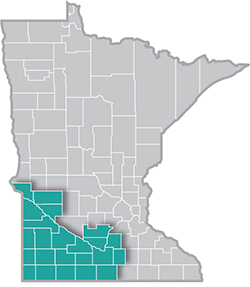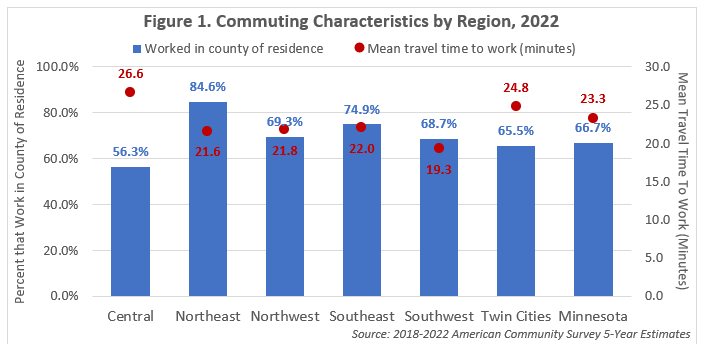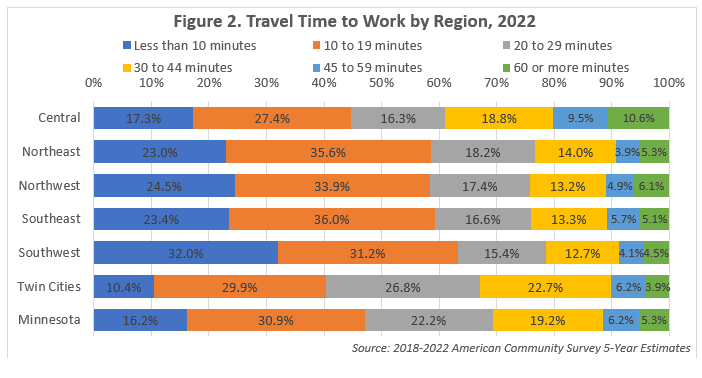 Southwest Minnesota is a national leader in agricultural production, and renewable energy.
Southwest Minnesota is a national leader in agricultural production, and renewable energy.
The region's thriving manufacturing sector includes food processing, machinery, printing, metal products, and computers and electronic products.
Want the freshest data delivered by email? Subscribe to our regional newsletters.
3/26/2024 9:00:00 AM
Luke Greiner, Amanda O'Connell
Southwest Minnesota has the shortest commute times in the state, with workers averaging less than 20 minutes each way to work. The region's mean travel time of 19.3 minutes was 4 minutes shorter than the state average, and almost 7.5 minutes shorter than the average one-way commute in Central Minnesota, which reached 26.6 minutes in 2022. In sum, more than two-thirds of workers in Southwest Minnesota reported working in their county of residence, about 2 percentage points ahead of the state as a whole (see Figure 1).

Interestingly, that was only the fourth highest rate among the six planning regions, meaning that residents are making the most of regional interconnections and employment centers. By choosing to live near where they work, nearly one-third (32.0%) of workers in Southwest Minnesota reported a travel time under 10 minutes, nearly double the rate in Minnesota as a whole (16.2%). Less than 9% of residents in the region commuted more than an hour each way to work, which was the lowest rate in the state (see Figure 2).

Less than 2.5% of workers commuted outside the state for their jobs, though it varied throughout the region. Obviously border counties had higher rates of inter-state workers, as demonstrated by the Census Bureau's OnTheMap tool. Just over one-quarter (25.2%) of workers in Rock County, which is just east of the Sioux Falls, SD metro area, worked outside their state of residence, followed by Big Stone County at 18.2% (where people commute to Milbank in Grant County, SD), Pipestone County at 9.4% (where people also commute to Sioux Falls, SD), and Jackson County at 7.3% (where people commute to Spirit Lake in Dickinson County, IA). In contrast, nine of the 23 counties in the region had less than 1% of their residents working out of state.
Lyon County boasted the shortest average travel time in the region, at just over 15 minutes one way in 2022. Not surprisingly, it also had the highest percentage of workers who worked in their county of residence, with just over 91.2% both living and working in Lyon County. In contrast, less than 50% of workers in both Sibley and Le Sueur County worked in their county of residence, and consequently had the longest average commutes in the region, at nearly 26 minutes (see Table 1).
| Table 1. Commuting Characteristics by County, 2022 | Worked in state of residence | Worked in county of residence | Worked out of county of residence | Worked outside state of residence | Mean travel time to work (minutes) |
|---|---|---|---|---|---|
| Lyon County | 99.0% | 91.2% | 7.8% | 1.0% | 15.2 |
| Brown County | 99.7% | 84.7% | 15.0% | 0.3% | 15.7 |
| Cottonwood County | 98.0% | 79.0% | 19.0% | 2.0% | 16.1 |
| Lac qui Parle County | 96.1% | 72.5% | 23.6% | 3.9% | 17.0 |
| Pipestone County | 90.6% | 79.4% | 11.1% | 9.4% | 17.1 |
| Nicollet County | 99.6% | 52.0% | 47.7% | 0.4% | 17.2 |
| Blue Earth County | 99.7% | 76.6% | 23.2% | 0.3% | 17.4 |
| Jackson County | 92.7% | 67.8% | 24.9% | 7.3% | 17.5 |
| Martin County | 98.7% | 84.0% | 14.7% | 1.3% | 17.6 |
| Redwood County | 99.6% | 78.3% | 21.3% | 0.4% | 17.7 |
| Rock County | 74.8% | 64.2% | 10.7% | 25.2% | 18.1 |
| Big Stone County | 82.0% | 65.6% | 16.3% | 18.0% | 18.3 |
| Nobles County | 92.9% | 79.4% | 13.5% | 7.1% | 18.9 |
| Chippewa County | 99.9% | 71.1% | 28.8% | 0.1% | 19.2 |
| Faribault County | 97.5% | 69.6% | 28.0% | 2.5% | 19.4 |
| Swift County | 98.3% | 68.7% | 29.5% | 1.7% | 20.8 |
| Yellow Medicine County | 98.0% | 56.1% | 41.9% | 2.0% | 20.9 |
| Murray County | 98.4% | 60.7% | 37.7% | 1.6% | 21.0 |
| Watonwan County | 99.8% | 64.6% | 35.2% | 0.2% | 21.5 |
| Waseca County | 98.5% | 50.7% | 47.8% | 1.5% | 22.4 |
| Lincoln County | 88.0% | 54.1% | 33.8% | 12.0% | 22.8 |
| Sibley County | 99.6% | 46.8% | 52.8% | 0.4% | 25.7 |
| Le Sueur County | 99.6% | 41.3% | 58.3% | 0.4% | 25.8 |
| Source: 2018-2022 American Community Survey 5-Year Estimates | |||||
Employers in these counties that are looking for workers may find success by retaining residents within the county instead of losing them to other employment centers. Workers consider many factors when choosing a job, including wages, benefits, match with skills and training, schedule flexibility, career opportunity and more; but certainly also consider commuting.
In addition to these insights, the Census Bureau commuting characteristics data provides a lot of additional detail, including means of transportation, time leaving home to go to work, number of vehicles available and a breakdown by gender. Counties can use this data to better understand their workforce, and employers can use it to target potential workers who may be closer to home than they think.
Contact Luke Greiner at luke.greiner@state.mn.us or Amanda O'Connell at amanda.oconnell@state.mn.us.